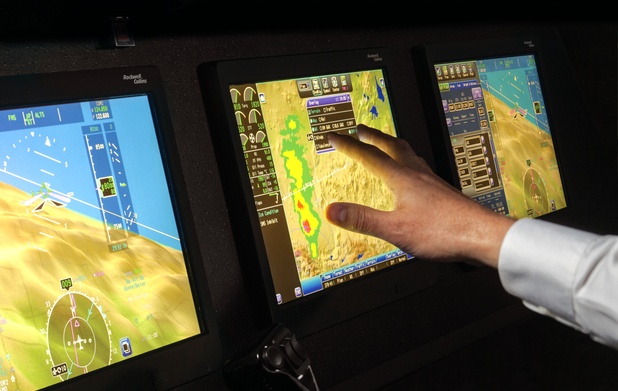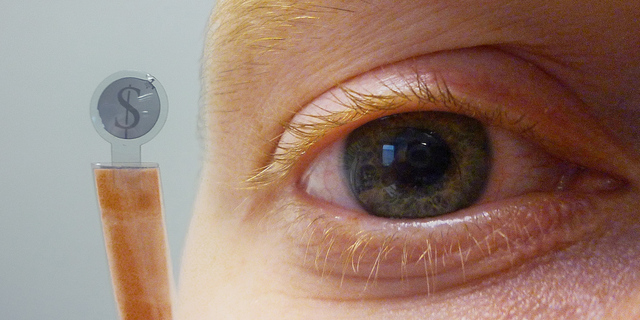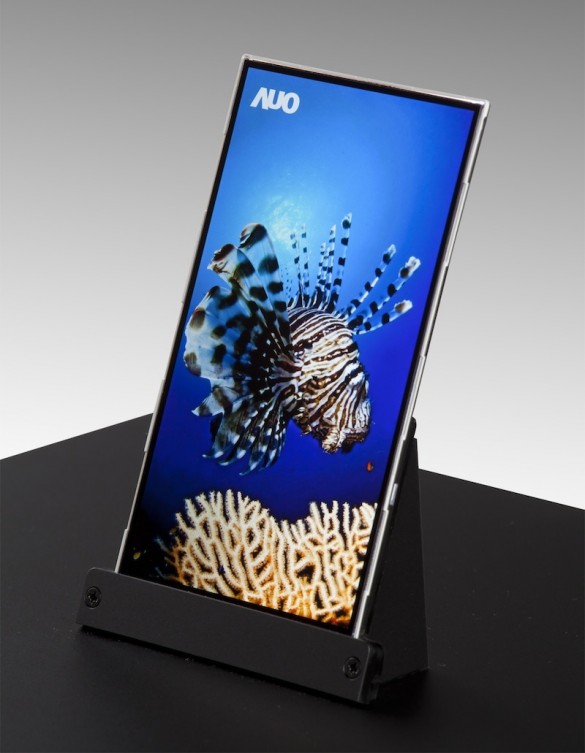Display Technology News Roundup 2.9.2014

Image via Macworld
Why doesn't Apple does make a touchscreen MacBook? "The appointment of Craig Federighi as the leader of all of Apple’s software efforts could have been seen as a sign of that merger, but Federighi himself is adamant that the Mac will always be true to itself. “The reason OS X has a different interface than iOS isn’t because one came after the other or because this one’s old and this one’s new,” Federighi said. Instead, it’s because using a mouse and keyboard just isn’t the same as tapping with your finger. “This device,” Federighi said, pointing at a MacBook Air screen, “has been honed over 30 years to be optimal” for keyboards and mice. Schiller and Federighi both made clear that Apple believes that competitors who try to attach a touchscreen to a PC or a clamshell keyboard onto a tablet are barking up the wrong tree. “It’s obvious and easy enough to slap a touchscreen on a piece of hardware, but is that a good experience?” Federighi said. “We believe, no.”" via Macworld
Will Your Next TV Be An LCD? Not If This Startup Has Its Way "Kateeva, which has 68 employees on board after acquiring OLED Plus in Korea today, has some intriguing technology that could change the game — and level the playing field at the same time. ...To date, all the OLEDs you’ve seen — whether on your Samsung phone, or one of the high-priced TVs — have been made using an expensive, wasteful, sloppy process. The OLED material is vaporized and then winds up on the screen once it re-forms into a solid. Merck, which supplies the chemicals that form the OLED material, believes this method has a dim future: “OLED production based on chemical vapor deposition can hardly be cost competitive to LCD,” it said in a recent presentation on the topic." via Forbes
Why Are Automotive LCD Instrument Panels On the Rise? "With drivers becoming increasingly inundated by technology in the dashboard, the focus for automotive designers and engineers has primarily been on the "center stack" of the interior, where primary screens and controls typically reside. But as LCDs are added to—and even take over—the instrument panel (IP) and displace analog gauges, some of the coolest innovations are happening right under drivers' noses — and appearing in lower-priced cars. ...The reason for this IP innovation is that drivers are being asked to process more information while behind the wheel, and automakers and their suppliers are tasked with presenting it in a way that doesn't divert attention away from the road." via PC Mag
Will New OTFTs Revolutionize Flexible Display Technology? "Adding to the growing list of companies or research firms that are exploring the technology, the UK-based Centre for Process Innovation (CPI) recently showed off its new backplane fabrication process that will allow organic thin film transistors (OTFT) arrays to be bent up to a radius of 1mm without showing any significant reduction in performance. As the technology advances, the OTFT arrays could potentially be integrated into foldable, ultra-flexible AMOLED backplanes. This in turn could open the door to all sorts of new types of flexible and foldable devices." via Android Authority
Display database for engineers Search thousands of display panels by multiple characteristics and compare results side-by-side using the display database multisearch.
Are AMOLED displays at risk of burn-in? "The problem is the “O” in the AMOLED acronym, which stands for “organic”. The organic compounds used in AMOLED displays are polymers or copolymers, such as polyfluorene (PFO) and polyphenylene vinylene (PPV), both of which degrade with use. This is partly due to the fact that the chemistry involved in creating the electroluminescence is irreversible, so the luminous pixels degrade as they’re used up, like a battery. These organic materials tend to crystallise, too – an effect that is exacerbated at higher temperatures. That’s something to bear in mind the next time your phone becomes warm while you’re playing a game or watching a video." via PC Pro
Will Chinese display panel manaufacturers pose a threat to Taiwan manufacturers? "Taiwanese flat-panel makers could see their position in China threatened by local rivals by 2016, when Chinese firms are expected to begin mass producing next-generation products, a local market researcher predicted on Wednesday. Mass production of panels started at two advanced Chinese plants in the third quarter of 2011, and four others are expected to catch up by 2016, moving China forward in the panel industry, according to Delux Chen, a flat-panel industry analyst at the Photonics Industry and Technology Development Association (PIDA)." via Want China Times
Taiwan's TAITRA looking for next big thing in display panel sector "Most notably, TAITRA Chairman Wang Chih-kang [in January] urged Taiwan's display panel makers to ramp up efforts toward innovating new products and developing new technologies amid heightened competition from mainland China. China last year imported about US$4.5 billion worth of display panels from Taiwan, said Wang. With production capacity growing rapidly across the strait, and increased efforts from South Korean competitors in the China market, the industry may not be able to expect procurement to continue at volumes seen in previous years, Wang said. “While Taiwan still retains a lead in display technologies, innovation remains the only path for the sector's survival,” said Wang, while also urging structural reform across industries and further deregulation of Taiwan's market." via The China Post
F-35 Test Pilots Will Begin Flying “Gen” Helmet Display "Getting the HMDS right is a serious issue because the F-35, the DOD’s costliest weapons program, was designed without a pilot’s heads-up display, a feature that is common to fourth-generation fighters. In September 2011, F-35 prime contractor Lockheed Martin (Stand CS02) awarded a contract to BAE Systems (Stand U67) to develop an alternate HMDS with detachable night-vision goggles (NVGs) as a fallback system in the event VSI failed to resolve issues with the chosen helmet-mounted display." via AIN Online
Can New HMI alternatives improve operations and cut costs? "The fewer moving parts of multitouch tablets make them a better choice for workers who visit dusty, wet, and corrosive environments. Industrial tablets have the durability required for these areas, and many can be operated while wearing gloves. Furthermore, they can improve worker safety through the creation of commands that cannot be performed unless both hands are on the screen. Although it is unlikely that businesses are going to swap their functioning screens for new multitouch ones, it is highly probable they will replace worn-out screens with multitouch capability as the price for these devices drops. Multitouch functionality is also expected to become more ubiquitous due to the integrated support for the technology in new Windows operating systems. Eventually, all screens will likely have multitouch capability, so it is smart to select an HMI package that supports it." via InTech
Will OLET Slowly Encroach OLED Market? "The South Korean display industry has come out on top in LCD and OLED, becoming the envy of the world. Yet, Professor Lee Sin-doo is already making preparations for the future, refusing to sit on his laurels. What he is currently keen on is an organic light-emitting transistor (OLET). In contract to OLED that has two electrodes (the cathode and anode), OLET, a new light-emission concept, comes with three electrodes, giving it a competitive edge over OLED. OLET uses network electrodes, so it can emit light in the same structure without being affected by the type of substrates. The centerpiece of OLET lies with addressing OLED’s shortcomings. The supply of light though vertical-type organic transistors can solve OLED’s problems, so OLET will soon take over from OLED." via Korea IT Times
Will Wearable Tech Change the Smartphone as You Know It? "CA Technologies CTO John Michelsen thinks that if wearable technology does replace the smartphone, next-generation display technology will need to play a key role. "It depends on the visual technology. It's the display," Michelsen says. "What am I going to do when someone emails me an Excel file and I need to do a quick review and respond? The smartphone is barely viable as it is. If we can get display tech that lets me hit a button for a display, I think the cell phone goes away."" via CIO
Do you have content to share with Display Alliance? Anyone can post press releases, white papers, commentary, videos, and more in the open section.
How the Avegant Glyph's virtual retinal display mesmerizes "Unlike most headset displays that are built around a small digital screen, the Glyph creates an image by reflecting a low-powered color LED onto an array of two million tiny mirrors. The micromirrors shape the light into a two-dimensional image, which is then beamed straight onto the wearer's retina – hence why they're referring to it as a "virtual retinal display." Since you aren't looking directly at the light source, the image comes off as more true-to-life and, according to the designers, reduces eye fatigue." via Gizmag
How display technology based on EYEBALLS makes devices more readable "Phones typically have a light sensor which ramps the backlight up and down based on the ambient light conditions. This is a limited solution, however, as daylight can be fifty times brighter than indoor lighting. The human eye copes with this well; transmissive technologies like LCD and OLED can't. Apical's technology counters this by modifying the image, pixel by pixel, based on the ambient light, the direction of the light and the estimated viewing angle. By increasing the contrast with this "assertive" display they can keep the image on your device readable as you move from indoors to outdoors." via The Register
Japan Display announces mass production of Memory-In-Pixel reflective-type LCD module "Since the MIP structure can keep screen images in the static random access memory transistor fabricated in each sub-pixel, in the case of still images, once data is written it is kept, and ultra-low power consumption is achieved. The new scattering layer optimizes the panel’s optical design, and enables a near paper-like display. Since the display consumes very little electricity it is suitable for ultra-low power applications, like wearable devices, which are not recharged for long periods of time. " via Fareastgizmos
How a new transparent display system could provide heads-up data "Many current “heads-up” display systems use a mirror or beam-splitter to project an image directly into the user’s eyes, making it appear that the display is hovering in space somewhere in front of him. But such systems are extremely limited in their angle of view: The eyes must be in exactly the right position in order to see the image at all. ...The secret to the new system [from MIT researchers]: Nanoparticles are embedded in the transparent material. These tiny particles can be tuned to scatter only certain wavelengths, or colors, or light, while letting all the rest pass right through. That means the glass remains transparent enough to see colors and shapes clearly through it, while a single-color display is clearly visible on the glass." via MIT
How to make your gloves touchscreen capable "Our favorite method, however, is also the easiest, as it involves using a product made specifically for this job, Any Glove. A liquid material that you squeeze out onto your glove and let dry, Any Glove works on most materials, including fleece, knits, and synthetic suede. A separate solution is available for leather. And it doesn’t wash off when you wash your gloves. Any Glove has also earned approval for use on combat gloves by the U.S. Armed Services, so, you know, it’s got that going for it." via TechHive
Are you an engineer or have display expertise? Email jason@displayalliance.com to be featured in the interviews section.
How an HMI Can Make a Good Machine Better "The company wanted to upgrade its product line of smart roasters with a new human machine interface (HMI) that would take operator productivity, connectivity and efficiency to the next level of operational excellence. “The touch panel interface is the key point of contact for the roaster operator,” said Ludwig, and improving the interaction and control of roasters by adding advanced functionality and remote monitoring capabilities would help customers meet key performance indicator (KPI) metrics and goals." via AutomationWorld
How this 3D holographic display makes Star Wars a reality "The technology behind the Voxiebox is much simpler than it would seem. The device contains a projector that beams an image up onto a screen, which in turn vibrates up and down at a rapid speed. The rapid vibration allows the image to appear as though it’s a 3D asset. If that’s tough to picture, think of it as similar to those light trail pictures that frequently pop up on social networks. You can circle around the Voxiebox and the image quality never wavers or fades out of view. The only way the image will disappear is if you look at the display’s base head-on; you’re supposed to look at it from an overhead angle similar to the camera orientation in games like Diablo." via ExtremeTech
What are the technical merits of the pixel density race? "If there is any single number that people point to for resolution, it is the 1 arcminute value that Apple uses to indicate a “Retina Display”. This number corresponds to around 300 PPI for a display that is at 10-12 inches from the eye. In other words, this is about 60 pixels per degree (PPD). Pixels per degree is a way accounting for both distance from the display and the resolution of the display, which means that all the information here is not limited to smartphone displays, and applies universally to any type of display. While this is a generally reasonable value to work with, the complexity of the human eye and the brain in regards to image perception makes such a number rather nebulous." via AnandTech
Can Malware Log Touchscreen Swipes To Record Your PIN? "Recording touch screen coordinates “has a certain value in itself,” Hindocha says. “If you’re monitoring all touch events and the phone hasn’t been touched for at least one hour, then you get a minimum of four touch events, you can assume that is a PIN code being entered.” “The more interesting thing is, if you get a screenshot and then overlay the touch events, you’re looking at a screenshot of what the user is seeing, combined with dots, sequentially, where the user is touching the screen.”" via Forbes
What did you think about today's news? Leave a comment here and share your thoughts.
 News Roundup tagged
News Roundup tagged  AMOLED,
AMOLED,  Apple,
Apple,  Automotive,
Automotive,  Avionics,
Avionics,  China,
China,  Head-mounted display,
Head-mounted display,  Human Machine Interface,
Human Machine Interface,  Japan,
Japan,  LCD,
LCD,  OLED,
OLED,  Taiwan,
Taiwan,  Touchscreen
Touchscreen 









